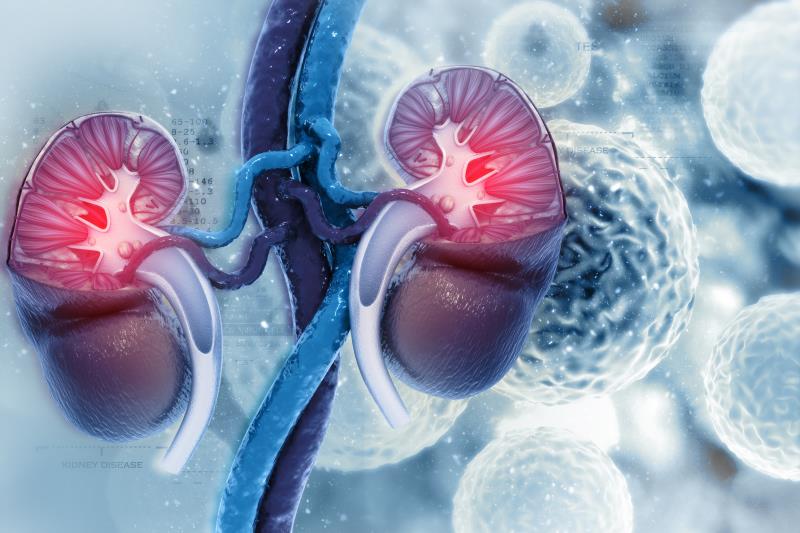Does urate-lowering with allopurinol prevent kidney disease progression?





Two phase III trials have shown that reducing serum urate (SU) levels with allopurinol did not provide a clinically meaningful benefit in individuals with kidney disease.
The CKD-FIX* trial showed that the urate-lowering effect of allopurinol did not attenuate the decline in estimated glomerular filtration rate (eGFR) among individuals with stage 3/4 chronic kidney disease (CKD). A similar outcome was seen in the PERL** trial, which evaluated patients with type 1 diabetes (T1D) and diabetic kidney disease.
CKD-FIX
This comprised 369 adults (mean SU level 8.2 mg/dL, 76 percent on RAS*** inhibitors) who were randomized 1:1 to receive allopurinol 100–300 mg QD or placebo. The trial included a dose-escalation phase# (12 weeks) and a long-term follow-up phase (92 weeks). [N Engl J Med 2020;382:2504-2513]
At week 12, mean SU level dropped to 5.1 mg/dL with allopurinol, and remained at 5.3 mg/dL up to week 104. No change was observed with placebo across the 2-year trial period.
Despite the SU reduction, no significant between-group difference was observed in mean eGFR level (–0.10 mL/min/1.73 m2/year; p=0.85). This was mirrored in the sensitivity analyses## (mean differences ranging from 0.00 to –0.10).
“[These suggest that] treatment with allopurinol did not result in slower eGFR decline vs placebo over the 104-week follow-up period despite a sustained mean reduction of 35 percent in SU levels,” said the researchers.
“[Therefore,] our results do not appear to support the view that circulating urate levels play a causal role in the progression of CKD. Evidence … shows only an association between urate levels and progression of CKD, not a cause-and-effect relationship,” they continued.
The researchers also said that it appears unlikely that RAS inhibitors tempered the effects of allopurinol, citing evidence suggesting that urate lowering with allopurinol had no influence in the kidney-specific or systemic activity of RAS. [J Am Soc Nephrol 1998;9:310-313]
Moreover, the second post hoc futility analysis seemed to support the inefficacy of allopurinol in this setting. “[H]ad we enrolled the 1,006 patients needed to maintain sufficient power to accommodate [the 30 percent] of patients having discontinued allopurinol, we still would have had a relatively low probability of finding a significant effect of the drug,” they stressed.
“The lack of benefit of allopurinol in slowing [CKD] progression … is noteworthy because we specifically enrolled patients who had an elevated risk of progression in order to maximize the potential to show an effect of allopurinol on the decline in eGFR,” they added.
PERL
In PERL, 530 participants (mean SU level 6.1 mg/dL, 90 percent on RAS inhibitors) were also randomized 1:1 to receive allopurinol### or placebo. Intervention period ran for 3 years, followed by a 2-month washout period. [N Engl J Med 2020;382:2493-2503]
During the intervention phase, mean SU level progressively dropped to 3.9 mg/dL with allopurinol and did not change with placebo.
As in CKD-FIX, SU reduction did not entail significant changes in GFR, as evidenced by the minimal between-group difference in mean iohexol-based GFR (–0.6 mL/min/1.73 m2/year). The end of the washout phase saw identical mean iohexol-based GFR in both arms (61.2 mL/min/1.73 m2; p=0.99).
Preclinical and observational studies suggest that SU is a potential target for treating early diabetic kidney disease. [Contrib Nephrol 2018;192:103-109] However, the findings suggest that, despite the sustained SU reduction for 3 years (which was longer than in CKD-FIX) with allopurinol, it did not mitigate the rate of GFR decline among adults with T1D, noted the researchers.
The secondary outcomes and subgroup analyses confirm that the reduction of SU level through allopurinol does not effectively alter the progression of diabetic kidney disease in individuals with T1D, they said.
Despite the large sample, the findings may not be applicable to other ethnicities/races given the predominantly white population. The results may also not be applicable to patients in other stages of diabetic kidney disease, those with type 2 diabetes, or those with other causes of CKD. “However, the similarly neutral results of CKD-FIX make it unlikely that reduction in the SU level would benefit persons with these other conditions,” they pointed out.

Not for CKD control
The increasing prevalence and severity of CKD carries a tremendous financial and health burden, hence the importance of mitigating CKD progression, noted Dr Daniel Feig from the University of Alabama School of Medicine in Birmingham, Alabama, US, in an editorial. [N Engl J Med 2020;382:2567-2568]
“The finding that middle-aged persons with diabetic nephropathy (PERL) or with advanced, rapidly progressing proteinuric kidney disease (CKD-FIX) do not have a reduction in CKD progression beyond standard of care with RAS inhibition when treated with allopurinol indicates that, for such patients, allopurinol is not indicated for CKD control,” said Feig.
“[Although] PERL and CKD-FIX … provide guidance about the real-world efficacy of clinical interventions … generalizations must be made with caution,” he noted, calling for more high-quality randomized studies to address urate-lowering therapy in other settings (eg, younger patients, earlier CKD stages).